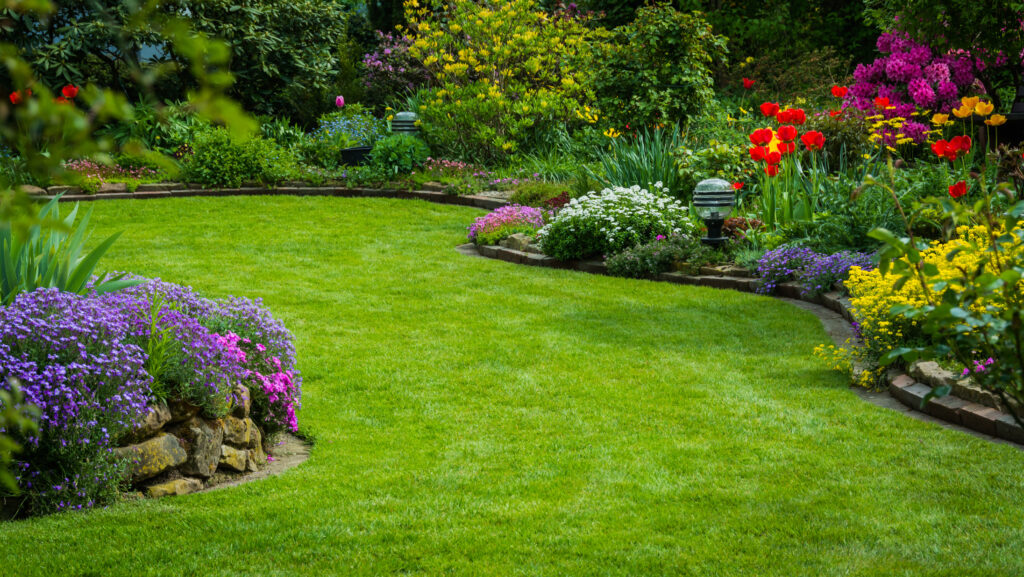
Maintaining a beautiful lawn is essential for enhancing your garden’s overall appeal. In South Africa, the key to a thriving lawn involves seasonal care, including fertilization, weeding, aeration, and mowing. Follow this guide to ensure your lawn remains lush and healthy throughout the year.
Garden Care Starts with the Lawn
A well-maintained lawn is often the focal point of a garden. Mastering lawn care can make other garden maintenance tasks seem effortless. Here’s how to manage your lawn throughout the seasons:
Spring and Summer Lawn Care
1. Fertilize Your Lawn: Step-by-Step
1. Scarify
- Purpose: Removes dead, matted grass, especially on stolon-type Cynodon species or frosted kikuyu lawns.
- Method: Set your lawnmower to a low setting and cut away at least half of the dead grass. Rake and remove the remaining thatch until only a sparse covering of dead grass remains. Note: Avoid scarifying bunch-type, cool-season, evergreen grasses.
2. Aerate
- Purpose: Improves drainage and reduces waterlogging.
- Method: Aerate heavy clay soils in early spring using a garden fork or a hollow-tined fork. This helps the grass grow better by allowing air, water, and nutrients to penetrate the soil.
3. Dress
- Purpose: Fills in holes and evens out the lawn.
- Method: Apply a lawn dressing—a mixture of sterilized soil and compost—over the lawn.
4. Fertilize
- Purpose: Encourages thick, green growth.
- Method: Use Wonder Lawn & Leaf fertiliser, following the recommended application rates for optimal results.
2. Caring for Your Lawn
Weeding
- Method: Apply selective broadleaf herbicides to remove unwanted weeds. For effective results:
- Mix Efekto Hormoban APM or Efekto Turfweeder and spray using a pressure sprayer.
- Use Efekto No Weed Lawn RTU for broadleaf weeds.
- For buffalo grass, use Efekto Banweed MCPA, or Efekto No Weed Lawn ready-to-use for spot treatments.
- Tip: Always read product labels and ensure suitability for your grass type.
Feeding
- Continue to feed your lawn every 6-8 weeks to promote healthy growth.
Rejuvenating
- Overseed bare patches and compacted areas to ensure even coverage and density.
Mowing
- Maintain a consistent mowing schedule to keep your lawn looking neat. Adjust mowing height according to the season and grass type.
Insects
- Monitor for pests and treat as necessary with appropriate insecticides or natural remedies.
Autumn and Winter Lawn Care
1. Keep the Surface Clear
- Purpose: Prevents disease and helps the grass breathe.
- Method: Remove fallen leaves weekly to avoid suffocating the grass. Use a rake to collect leaves for composting.
2. Rake the Surface
- Purpose: Helps water penetration and prevents thatch buildup.
- Method: Lightly rake the lawn to break up thatch and improve water infiltration.
3. Weeding
- Method: Continue to remove weeds as they appear to prevent them from competing with your grass for nutrients.
4. Feeding
- Purpose: Prepares the lawn for the winter months.
- Method: Apply a winter fertilizer that promotes root growth and prepares the lawn for spring.
5. Repairing
- Purpose: Fix damage from summer wear.
- Method: Re-seed or patch areas that are thin or damaged to ensure a robust lawn in spring.
6. Insects
- Method: Treat any remaining insect problems before the onset of colder weather to protect your lawn.
Gardening Calendar
To optimize your lawn care and other gardening tasks, refer to a monthly gardening calendar. This helps you align your maintenance activities with the seasonal needs of your plants and lawn.
